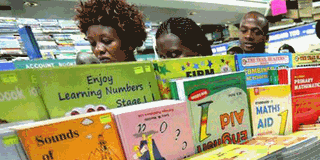How private sector can spur textbook trade

Parents shop for textbooks at Savannah Books Centre in Nairobi on January 2, 2015. Textbooks, meanwhile, are rarely discussed as an investment, yet they are one of the most effective ways to improve students’ learning. PHOTO | BILLY MUTAI | NATION MEDIA GROUP
What you need to know:
- In Kenya, as in many other sub-Saharan Africa, textbooks are becoming less accessible over time, rather than the reverse.
- In 22 sub-Saharan African countries, providing one textbook to every student in a classroom increased literacy scores by up to 20 per cent.
- This is why our paper has investigated the benefits of shifting to a nationally centralised textbook system, which would pool demand for textbooks and ensure long-term and predictable financing.
Calls to improve education most frequently circulate around the need for better prepared teachers, improved governance, expanded infrastructure and a relevant curriculum.
Changes in these areas take time; investments in them are not easily quantifiable, and may reduce the financial attraction of the private sector.
Textbooks, meanwhile, are rarely discussed as an investment, yet they are one of the most effective ways to improve students’ learning.
For the private sector in particular, they provide a straightforward and effective way to invest in education and see tangible results.
And there is real pressing need for this investment.
A new paper by the Global Education Monitoring (Gem) Report at Unesco shows that cutting through debates about the quality of textbooks is a fundamental problem: millions of children simply do not have access to such materials at all.
In Kenya, as in many other sub-Saharan Africa, textbooks are becoming less accessible over time, rather than the reverse.
Without textbooks, children end up spending too many of their school hours copying content from the blackboard, which severely reduces time for engaged learning.
In 22 sub-Saharan African countries, providing one textbook to every student in a classroom increased literacy scores by up to 20 per cent.
While the buck should stop with governments, they are currently not investing enough in textbooks.
In 2012, in 36 countries with data, governments were spending less than 2 per cent of primary education budgets on teaching and learning materials on average, far less than the 3-5 per cent target recommended by the World Bank.
DIFFICULT TASK
The result is that parents are often left holding the burden; they are forced to cover the cost of learning materials for their children.
For the poorest children, this creates a vicious cycle: parents have precious few funds for textbooks, serving as an additional barrier to learning for the poorest.
While donors have tried to support government financing of textbooks and increase the capacity of local publishers, their efforts have been too few and often fragmented.
Getting a textbook to each and every child is not as easy as it sounds.
There are several steps to its production, including the development, procurement, distribution and storage, all of which have their own complications, including corruption and transport issues.
With so many parties involved in such a long process, the predictability of financing improves the chances that each child will possess a textbook.
Unfortunately, it is precisely this predictability that is lacking in many low-income countries.
Consider the situation in Africa where many countries have shifted towards decentralised textbook supply systems and away from ministries of Education deciding how many books each school should receive.
AN EFFECTIVE ALTERNATIVE
In practice, this has led to schools buying different combinations of textbooks for the same subjects and grades.
The result is neither cost-effective nor practical in providing uniformity across schools.
At the school level, the capacity to effectively forecast the demand for textbooks and other teaching and learning materials remains tenuous.
This is why our paper has investigated the benefits of shifting to a nationally centralised textbook system, which would pool demand for textbooks and ensure long-term and predictable financing.
According to our estimates, this could take up to $3 off the price of each book, saving almost $1 billion in sub-Saharan Africa alone.
Kenya could save $64 million from its textbook bill.
Pooling and forecasting demand in this way would open the door for innovative financing mechanisms that could present smart investments for the private sector.
A similar approach has been used by the health sector to finance vaccines through the Gavi, the Vaccine Alliance.
Dr Benavot is the director of the GEM Report, Unesco




